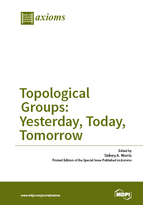Topological Groups: Yesterday, Today, Tomorrow
A special issue of Axioms (ISSN 2075-1680). This special issue belongs to the section "Geometry and Topology".
Deadline for manuscript submissions: closed (30 September 2015) | Viewed by 50288
Special Issue Editor
2. Department of Mathematical and Physical Sciences, La Trobe University, Melbourne, VIC 3086, Australia
Interests: topological groups; especially locally compact groups; pro-Lie groups; topological algebra; topological vector spaces; Banach spaces; topology; group theory; functional analysis; universal algebra; transcendental number theory; numerical geometry; history of mathematics; information technology security; health informatics; international education; university education; online education; social media in the teaching of mathematics; stock market prediction; managing scholarly journals
Special Issues, Collections and Topics in MDPI journals
Special Issue Information
Dear Colleagues,
In 1900, David Hilbert asked whether a locally euclidean topological group is in fact a Lie group. This was the fifth of his famous 23 questions which foreshadowed much of the mathematical creativity of the twentieth century. It required half a century of effort by several generations of eminent mathematicians until it was settled in the affirmative. These efforts resulted over time in the Peter-Weyl Theorem, the Pontryagin-van Kampen Duality Theorem for locally compact abelian groups, and finally of the solution of Hilbert 5 and the structure theory of locally compact groups, through the combined work of Andrew Gleason, Kenkichi Iwasawa, Deane Montgomery, and Leon Zippin. For a presentation of Hilbert 5 see the 2014 book “Hilbert’s Fifth Problem and Related Topics” by the winner of a 2006 Fields Medal and 2014 Breakthrough Prize in Mathematics, Terence Tao.
It is not possible to describe briefly the richness of topological group theory and the many directions taken since Hilbert 5. The 900 page reference book in 2013 “The Structure of Compact Groups” by Karl Hofmann and I, deals with one aspect of compact group theory. There are several books on profinite groups including those written by John S. Wilson (1998) and by Luis Ribes and Pavel Zalesskii (2012). The 2007 book “The Lie Theory of connected pro-Lie groups” by Karl Hofmann and me, demonstrates how powerful Lie Theory is in exposing the structure of infinite-dimensional Lie groups.
The study of free topological groups initiated by S. Kakutani, A.A. Markov and M.I. Graev has resulted in a wealth of interesting results, in particular those of A.V. Arkhangelʹskiĭ and many of his former students who developed this topic and its relations with topology.
Compactness conditions in topological groups has been another direction which has proved very fruitful to the present day.
In this Special Issue, we particularly seek contributions of the following two kinds:
- survey articles which present significant (new or not so new) open questions;
- new results on topological groups presented in a historical context and with open questions.
Prof. Dr. Sidney A. Morris
Guest Editor
Manuscript Submission Information
Manuscripts should be submitted online at www.mdpi.com by registering and logging in to this website. Once you are registered, click here to go to the submission form. Manuscripts can be submitted until the deadline. All submissions that pass pre-check are peer-reviewed. Accepted papers will be published continuously in the journal (as soon as accepted) and will be listed together on the special issue website. Research articles, review articles as well as short communications are invited. For planned papers, a title and short abstract (about 100 words) can be sent to the Editorial Office for announcement on this website.
Submitted manuscripts should not have been published previously, nor be under consideration for publication elsewhere (except conference proceedings papers). All manuscripts are thoroughly refereed through a single-blind peer-review process. A guide for authors and other relevant information for submission of manuscripts is available on the Instructions for Authors page. Axioms is an international peer-reviewed open access monthly journal published by MDPI.
Please visit the Instructions for Authors page before submitting a manuscript. The Article Processing Charge (APC) for publication in this open access journal is 2400 CHF (Swiss Francs). Submitted papers should be well formatted and use good English. Authors may use MDPI's English editing service prior to publication or during author revisions.
Keywords
- topological groups
- compact groups
- profinite groups
- locally compact groups
- Lie groups
- pro-Lie groups
- almost periodic
- semitopological groups
- structure theory
- transformation groups
- representations
- free topological groups and free products
- variety of topological groups
- Hilbert’s 5th problem
- (locally) minimal topological groups
- compactness conditions in topological groups
- duality and reflexivity
- covering theory for topological groups
- suitable sets for topological groups
- algebraic topology and topological groups
Benefits of Publishing in a Special Issue
- Ease of navigation: Grouping papers by topic helps scholars navigate broad scope journals more efficiently.
- Greater discoverability: Special Issues support the reach and impact of scientific research. Articles in Special Issues are more discoverable and cited more frequently.
- Expansion of research network: Special Issues facilitate connections among authors, fostering scientific collaborations.
- External promotion: Articles in Special Issues are often promoted through the journal's social media, increasing their visibility.
- e-Book format: Special Issues with more than 10 articles can be published as dedicated e-books, ensuring wide and rapid dissemination.
Further information on MDPI's Special Issue polices can be found here.
Related Special Issue
- Topological Groups in Axioms (38 articles)





